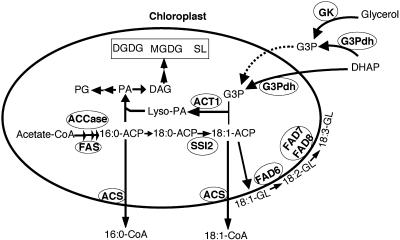Figure 8.
A condensed scheme for lipid biosynthesis and glycerol-mediated signaling in Arabidopsis leaves. De novo FA synthesis occurs exclusively in the plastids of all plant cells and leads to the synthesis of palmitic acid (16:0)-ACP and oleic acid (18:1)-ACP. These FAs enter glycerolipid synthesis either via the prokaryotic pathway in the inner envelope of chloroplasts or are exported out of plastids as CoA thioesters to enter the eukaryotic glycerolipid synthesis pathway. Desaturation of stearic acid (18:0)-ACP to 18:1-ACP catalyzed by the SSI2/FAB2-encoded stearoyl-ACP desaturase is one of the key steps in the FA biosynthesis pathway that regulates levels of unsaturated FAs in the cell. The 18:1-ACP generated in this reaction enters the prokaryotic pathway through acylation of G3P and this reaction is catalyzed by the ACT1-encoded G3P acyltransferase. G3P can be made via a cytosolic enzyme GK or via G3Pdh. Dotted line indicates that GK-derived G3P makes a minor contribution to the plastidal G3P pool. Desaturation of 18:1 to 18:2 and 18:3 on membrane glycerolipids (GL) is catalyzed by FAD6 and FAD7/FAD8-encoded desaturases, respectively, that are present on the plastid envelop. Esterification of the CoA group is mediated by acyl-CoA synthetase (ACS). CoA, Coenzyme A; Lyso-PA, acyl-G3P; SL, sulfolipid; DAG, diacylglycerol; DHAP, dihydroxyacetone phosphate.

